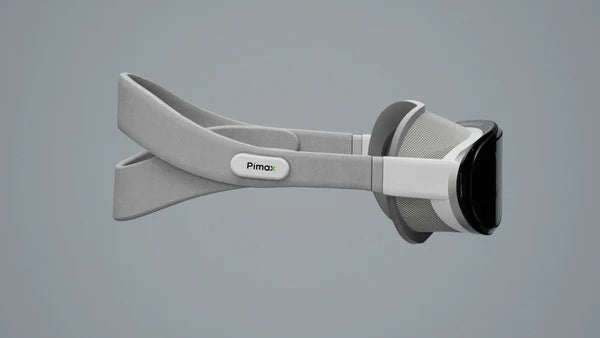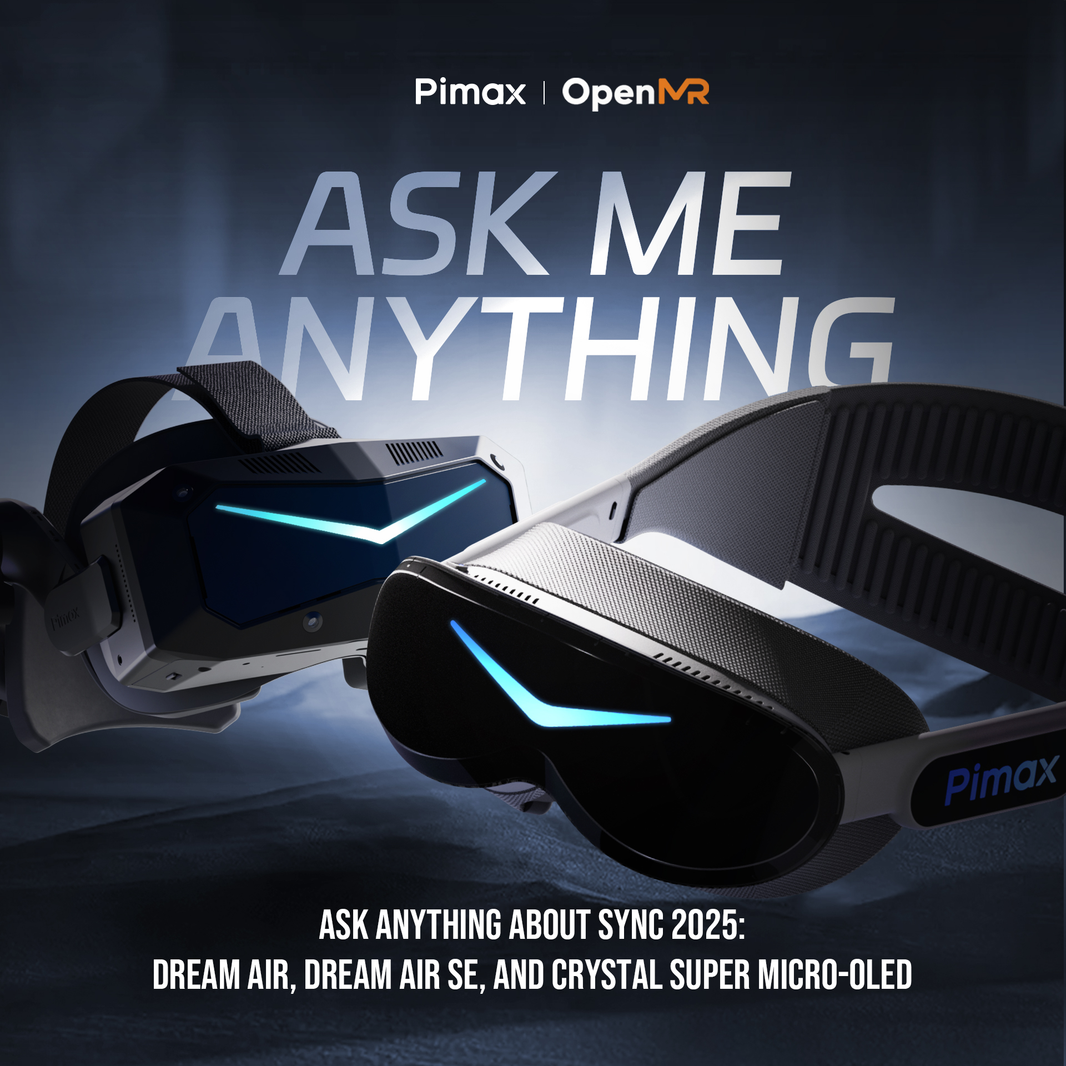Pimax announced the Pimax Dream Air on Monday. Here are some answers to some frequently asked questions.
Is a May shipping date realistic?
We've been developing the Crystal Super Micro-OLED and Dream Air internally for over a year now (they're essentially the same headset), and the optical engine is now fully functional. We're making steady progress with the remaining time, and are preparing for shipment in May, on a schedule similar to that of the Crystal Super.
The Dream Air uses the same optical engine as the Crystal Super, sharing the same underlying technology, but the design has been changed to a new form factor. You can learn more about the technical similarities between the Dream Air and Crystal Super here: Common Technology Between the Dream Air and Crystal Super .
Our current main challenges are procuring the Micro-OLED panel supply and the ring-less controller. (The initial shipment will use a ring-type controller similar to the Crystal/Light/Super series, which can then be replaced with a ring-less controller.) Nevertheless, we plan to ship 200 to 300 units in May, which is one of the reasons for this announcement.
Why did you announce Dream Air so soon after announcing Super, and why have you already started taking pre-orders?
There are a few reasons for this. First, we're announcing the Dream Air now because if we announced it after the Super had already started shipping, we might hear people say, "If only I'd known, I would have ordered the Dream Air." In fact, we've already seen comments like that on Discord, but users can change their Super preorders for the Dream Air.
Additionally, there are issues with the supply of Micro-OLED panels. Currently, demand for Micro -OLED panels far exceeds supply, resulting in delivery times of several months. Therefore, by accepting pre-orders early, we can determine how many headsets we need and place our Dream Air panel orders early. These orders must be placed in early January, and early processing is required due to the Chinese supplier's Lunar New Year holiday.
Pimax isn't unique in experiencing supply delays for Micro-OLED panels, as other companies are experiencing similar issues. However, Pimax pre-orders are refundable before shipping, and you can even trade in your headset once it arrives.
Why doesn't Pimax focus on one VR headset?
Pimax aims to diversify its VR headsets and is keen to offer multiple SKUs (product lines). As the uses of VR headsets rapidly expand, our goal is to always provide the best experience. To that end, we have developed two different lines, the Crystal Series and the Dream Series, to cater to a variety of usage scenarios.
All Pimax headsets share many common technologies, both software and hardware, and are all designed around PCVR, learning from past lessons (Portal, for example, was not PCVR) and continuing to evolve.
Pimax has been developing VR headsets for nine years, operates two R&D offices and a second assembly line, and is investing resources heavily to support this strategy.
Offering multiple SKUs allows us to maximize the technology common to all headsets, allowing us to devote more resources to development. This strategy also allows us to spread orders evenly without concentrated sales peaks, making it easier to manage supply and production.
Will Pimax release any new headsets in the future?
While some older models will be updated, there are currently no plans for a headset with more advanced specifications than the Dream Air or Crystal Super, with the exception of the 12K.
How far along is the development of Dream Air?
The internal design of the Dream Air is already complete, with a fully operational optical engine, and the software uses similar technology to the Crystal Super, including SLAM tracking for the headset and controllers, eye tracking, hand tracking, and Pimax Play setup.
Regarding the appearance, we are currently testing it with the Crystal Super housing, and the exterior design of the Dream Air is in progress.
This is an old prototype, but a new prototype will be released on December 30th.

Will Cobb ship in 2025?
We don't yet have an exact shipping date for Cobb. Cobb will be available as an option for the Dream Air and will add some features that we didn't mention at the Frontier launch.
What safety features are there to prevent harm if the self-tightening soft strap fails?
The main point is that it's designed to be strong enough to support a lightweight headset, but not so strong that it will hurt anyone. The internal straps are made of elastic rubber (and this technology isn't new; it's also used in automatic shoelaces like Nike's Auto Adapt).
What are the detailed product specifications of Dream Air?
Physical characteristics
- Weight: <200g
- connection:
- DP 1.4 (connection to PC), USB 3.0 Type C (connection to headset)
- Microphone * 2
- Type-C * 2 (The left Type-C port transmits video signals between the PC and the headset, and the right Type-C port is for users to connect their own accessories (such as audio equipment))
Interaction
Headset buttons:
- Tighten the straps
- Loosen the straps
- Volume Up
- Volume Down
tracking
- Pimax SLAM tracking (default setting), using 4x tracking cameras
- Headset Tracking
- Controller Tracking
- Hand Tracking
- Lighthouse (optional)
Integrated audio (speaker tube)
display
- Panel: 2 * 1.35 inch Micro-OLED
- Resolution: 3840*3552
- MTP latency: 15ms
- Refresh rate: 72Hz/90Hz
- Color Gamut: DCI-P3 100%
- Contrast ratio: 100000:1
optics
- Lens: Pancake * 2
- Weight: 20 grams (each lens)
- Viewing angle: 102° (horizontal)
- IPD (auto adjustment): 58mm-72mm
- Eye relief: 14mm
- Customized lens power: -300 to 900 degrees (for nearsightedness and farsightedness, sold separately)
- Integrated Eye Tracking
cable
- DP to Type-C
- Length: 5 meters
- Outer diameter: 5mm
Controller <br>Buttons:
- A (X)
- B(Y)
- Home
- Pimax Key
- trigger
- grip
- Joystick
- Headset Tracking
Battery life : 4-5 hours
- Capacity: 600mAH
- Charging: USB-C
- Weight: 126g
Other features
- Capsense
- Hand Tracking
- strap
Can I replace the soft strap? How?
Yes, the soft straps can be easily removed at the stem on either end.
Are there plans to make it work with HorizonOS or AndroidXR in the future?
Under the hood, it uses Crystal Super's Micro-OLED optical engine and works with Pimax Play as a PCVR headset (and also supports OpenXR/OpenVR runtimes and SteamVR).
Are there any wireless options, and are there any chances that accessories like Cobb could add functionality?
We are currently exploring wireless options with Cobb, but we are not yet sharing details as we are not sure if this will be possible.
Can eye tracking be used to control the user interface, and will gaze control be implemented in Pimax software?
Yes, we are currently considering these features (and are taking into account the progress of our competitors as we move forward with development).
Will Cobb be released at the same time as Dream Air, or at a later date?
Cobb will be released after Dream Air.
Does the Dream Air have a pass-through camera?
It's essentially the same headset, equipped with Crystal Super's Micro-OLED optical engine, so it has a black and white pass-through function, and we're currently considering adding a full color pass-through function.
I wish the tightness of the head strap could be adjusted to suit individual preferences, as I understand that the ideal fit varies from person to person.
Yes, there will be a button that allows you to manually adjust the tightness of the fit.
Can I change my Super reservation to Dream Air?
Yes, you can make changes through customer support if you provide your reservation number.
Are the controllers compatible with the Super?
The Dream Air is so compact that we think a ringless controller would be a better fit, but the controller itself uses the same technology and is compatible with all Crystal series headsets.
Does Crystal Super have hand tracking?
Yes, the Crystal Super also has hand tracking, but it may not be included at launch. That's why we didn't mention it at the time of the announcement. We're currently developing technology that can achieve this without a hand tracking module. This feature has been a goal from the beginning, and we've slightly changed the camera position compared to the Crystal Light.
Is this an entirely new headset?
No. The Micro-OLED optical engine in the Crystal Super and the Dream Air are 99% the same headset internally. It's essentially a scaled-down version of the Micro- OLED optical engine in the Super.
Are controllers compatible with Lighthouse?
No. The controller is the same as the Crystal, Crystal Light, and Crystal Super, but with a ring-less design.
Does this headset support base station tracking?
This is not supported as standard, but can be achieved by installing the Lighthouse faceplate.
Does the Pimax Dream Air's eye tracking work with UEVR and Luke Ross VR mods?
The Dream Air's eye tracking and DFR are identical to those of the Crystal and Crystal Super, and will work with games that support them, but currently UEVR and Luke Ross games do not appear to support them.
Do the OG Crystal owner discounts and 12K trade-in programs apply to Dream Air?
Yes, this applies to the Dream Air as well as the Crystal Super. However, you cannot use both at the same time. OG Crystal owners receive a ¥61,787 discount when purchasing Prime, but Crystal serial numbers and order numbers can only be used once. The same applies to the 12K trade-in program, where up to 50% of the trade-in value can be applied toward the purchase of a Super, and the remaining value can be applied toward the 12K. This discount applies to Prime, not the base price of the Crystal Super.
Why did you choose pancake lenses over aspherical lenses? I think aspherical lenses are better because they reduce glare.
If you want a wider FOV and aspherical lenses, we recommend Crystal Super. Its 50 PPD and 57 PPD optical engines are optimized for aspherical lenses and are used in conjunction with larger QLED panels.
There's no downward-facing camera, so how do you achieve hand tracking?
The cameras are ultra-wide and are currently being used to test hand tracking algorithms, a similar approach to the Meta Quest 3.
Is it wireless?
The Dream Air is a wired PC VR headset and does not have a battery, although battery functionality will be added later with the addition of Cobb (effectively making it a wireless headset).








